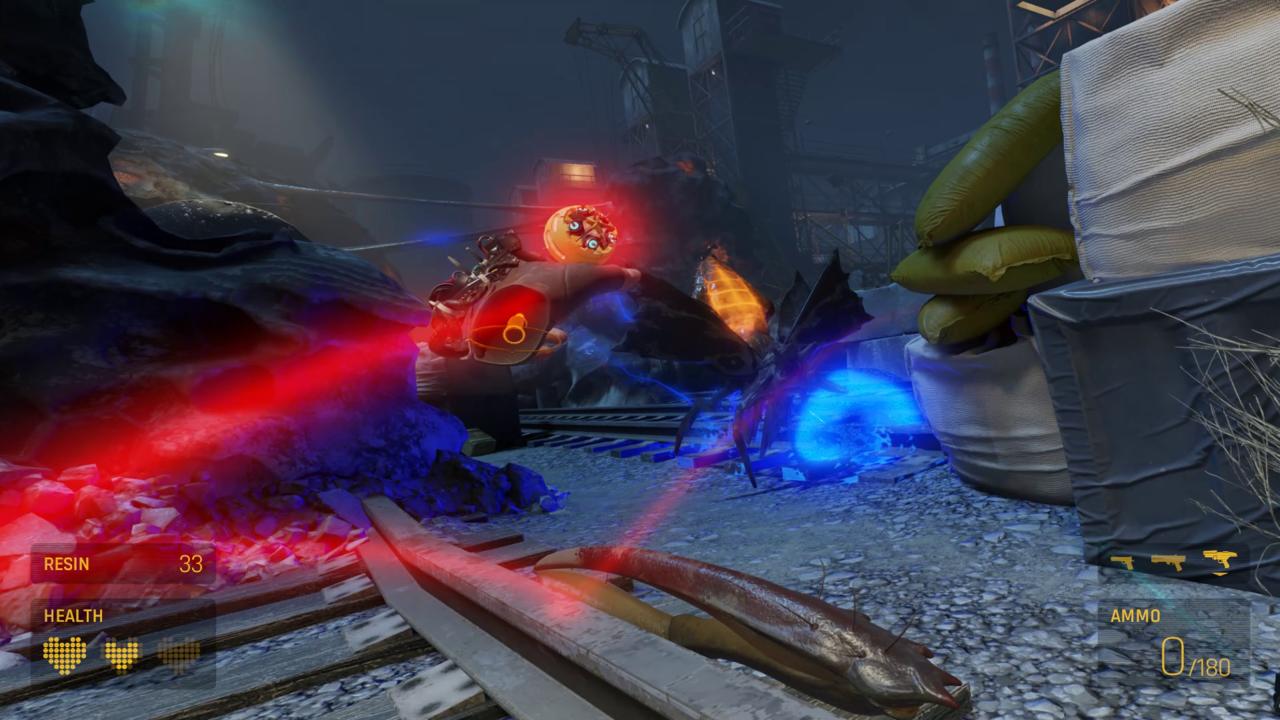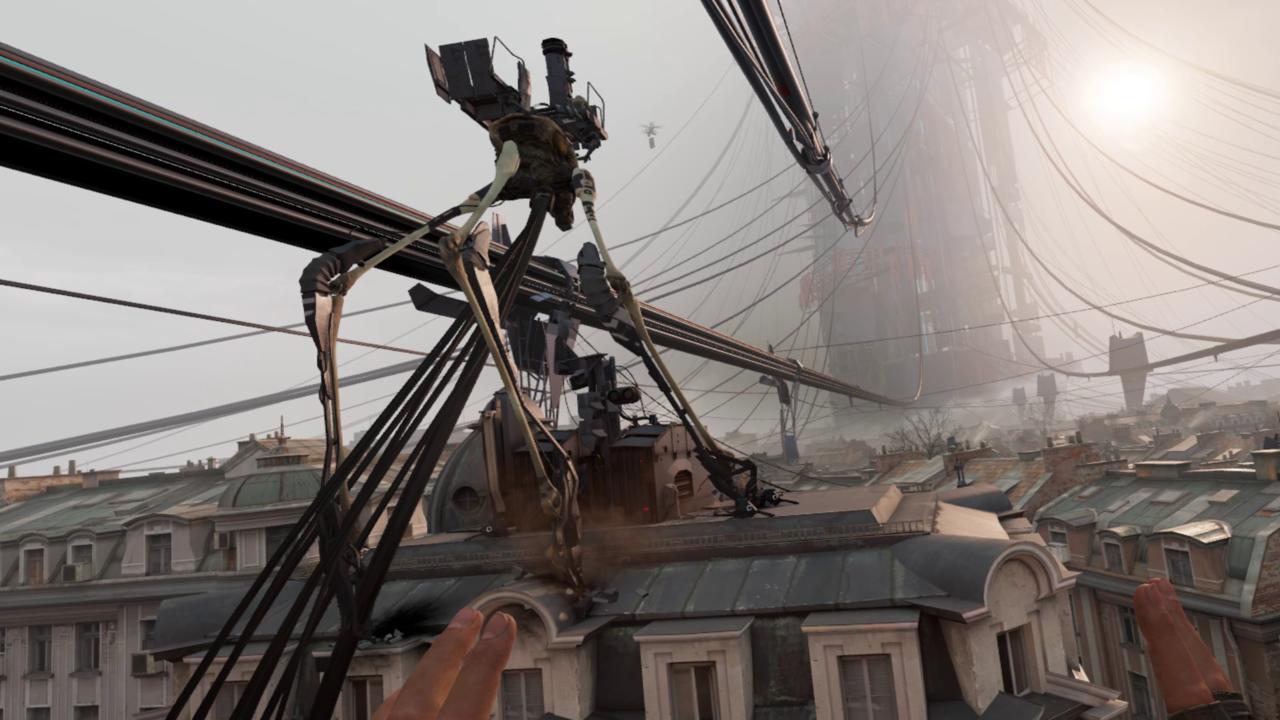Naturally, monumental expectations accompany the first Half-Life game in 13 years, and for the iconic franchise's return to come in the form of a VR exclusive is undoubtedly bold. But at each step of the way, Half-Life: Alyx proves that almost everything the franchise did best is elevated by VR: the environmental puzzles that require a keen eye, the threat of a headcrab jumping for your face, the cryptic storytelling. The series' staples are as great as ever here, and in its most powerful moments, Half-Life: Alyx confidently shows you why it couldn't have been done any other way.
What's a day in the life of Alyx Vance? In true Half-Life form, the entire game goes from morning to night in a single shot of first-person action in which you, as Alyx, trek through the undergrounds and abandoned zones of City 17. At first, it's to save your dad Eli Vance from the clutches of the Combine. However, you're subsequently led to uncover the nature of that massive floating structure that hovers over City 17, referred to as the Vault. With a cheeky sidekick Russell in your ear, and a trusty, prophetic Vortigaunt who comes in clutch, Alyx is more than prepared. A basic premise for sure, but the journey is thrilling, and the payoff is immense.
There's a newfound intimacy captured in doing the things that Half-Life always asked of you. Because it's a VR game, the way you look at and process your surroundings fundamentally changes, thus making the solutions to environmental puzzles more of a personal accomplishment than before. Simply finding the right objects to progress was fine with a keyboard and mouse, but when it's your own hands turning valves, moving junk to find critical items, pulling levers, or hitting switches while turning your head to see the results of your actions, these become enticing gameplay mechanics rather than means for breaking up the pace. Without waypoints or objective markers to guide you, subtle visual cues and calculated level design lead you to the solutions, and progress feels earned because of that.
You may not have the Gravity Gun here, but the spirit of its physics-based interaction lives through the Gravity Gloves, both as a sensible thematic fit and tool for proper VR gameplay. They allow you to magnetically pull in key objects from afar, and catching them midair is always satisfying--especially when snatching a grenade off a Combine soldier to throw it back in their face.
Not only has Half-Life: Alyx made good on its shift to VR, it has elevated many of the aspects we've come to love about Half-Life games.
What's just as important is Alyx's multitool, which serves as a way to engage in the game's simple yet enjoyable spatial puzzles. Rewiring circuitry to unlock paths forward is the multitool's most crucial function, though, so you'll need a sharp eye for tracing where wires and circuits lead and use the multitool's capability of exposing the flow of currents. Trying to find solutions can be frustrating at times, but once you understand the rules, how they grow more complex and incorporate the environment as the game goes on, it then gives way to a sense of accomplishment.

Half-Life: Alyx revolves around the balance of the aforementioned puzzle elements and its suspenseful combat scenarios. It may not have many of the bombastic firefights, helicopter chases, or seemingly insurmountable enemies from the series' past--most of that's been exchanged for close encounters, sometimes tapping into a horror element that Half-Life had only previously toyed with.
Headcrabs aren't the annoying pests they were before; at times, they're terrifying because they will literally latch onto your head or cause the occasional jump scare. The same goes for Barnacles; trust me when I say that you do not want your own virtual body dragged up toward the ceiling by its disgusting slimy tongue. Other scenarios play on navigating pitch-black darkness with your wrist-mounted flashlight as Xen creatures lurk about. There's also an entire chapter dedicated to "Jeff," an invincible mutant with sharp hearing who can't see, and he must be dealt with through clever environmental manipulation. A genuine dread you might not expect from Half-Life lingers throughout.
Combine soldiers may still be knobheads, but when they're chasing you down in VR and your sick headshot skills aren't there to save you, their threat becomes imminent and sometimes nerve-wracking. You'll hear the familiar radio chatter of the Combine, and feel relieved at the sound of the recognizable flatlining ring of a fallen Combine soldier. It's also nostalgic and oddly comforting to hear those signature old-school techno beats during most of these heated firefights, and then heal up on a health charger that uses the same sound effect since Half-Life 1. There aren't many types of Combine soldiers or styles of encounters, but I was always eager to face them head-on in each scenario.

Alyx herself packs light when it comes to weapons, with only a pistol, shotgun, and SMG. However, all three have a few upgrades to make them more effective, which must be done at Combine Fabricator stations at certain points in the game. The only real collectible is Resin, and pieces are scattered about each level. With ammo often scarce and Resin tucked away in corners, scavenging is a core element, further emphasizing Alyx's scrappy nature. And honestly, the slim arsenal fits the types of combat sequences throughout the game.
It's as satisfying to take your punchy shotgun to a Combine heavy as it is to ignite conveniently placed explode-y red barrels or clip weak points off Antlions with well-placed pistol shots when four or five of them are fast approaching. That's plenty to juggle in VR and strikes a balance between being simple enough to handle and complex enough to take advantage of VR's unique aspects. You'll physically duck in and out of cover and peek around corners ready to bust shots, and frantically string together the fun reload gestures as enemies barrel down on you--these are the qualities of any good VR shooter, though here, in its distinctly Half-Life form.
When looking at gameplay as a whole, Half-Life: Alyx takes many of the concepts we've seen evolve since VR's inception and distills them to their fundamentals. It executes most of them to a T, thus creating a VR experience that's a full, cohesive whole. A number of accessibility options are available as well; different movement and turning styles can help mitigate motion sickness, and there's a single-controller mode that allows you to performing all the game's necessary actions on one hand. You can also have crouching and standing actions mapped to buttons for height adjustment, making the seated VR experience better.

That said, environmental interaction isn't perfect. Doors and mechanisms you need to grip don't always react to your movements the way you'd expect, and sometimes there are just too many unimportant objects scattered about that obscure the thing you're actually trying to pull in with your Gravity Gloves. Thankfully, these instances are rare enough as to not drag down otherwise intuitive mechanics.
For as well-executed as its various elements are, the front half of the game does settle into a bit of routine. You may start to see through some of the trite aspects of the combat challenges, scripted sequences, and reliance on narrow corridors for stretches. At one point, I wondered where the game was going or why I was putting in this effort to get to this mysterious floating vault. But there comes a turning point, and the practiced routines pay off as you begin to feel the game's increasingly dangerous atmosphere.
The very concept of VR becomes the core narrative device--your hands, and by extension, Alyx's actions, are fundamental to the delivery of its best moments.
You'll be struck by the awe-inspiring sights throughout the journey across City 17, the thrill of firefights that ramp up in intensity while performing the VR-specific mechanics, and the unbearable suspense of some levels. Yet all those pale in comparison to the final hour, when Half-Life: Alyx solidifies itself as the boldest the series has ever been.
The very concept of VR becomes the core narrative device--your hands, and by extension, Alyx's actions, are fundamental to the delivery of its best moments. In its finality, you'll truly understand why VR was the only way this game could have even existed--it's something surreal, revelatory, and incredibly empowering. Half-Life: Alyx has far-reaching implications for the future of the franchise, both in where it goes next and what forms future games can even take. And in true Half-Life fashion, more questions than answers linger, but for good reason and not without a reminder of why you love the series to begin with.

Yes, this game is somewhat of a companion piece to mainline Half-Life games, taking place five years before Half-Life 2, but that doesn't really matter in the grand scheme of things. Disappointment you may have felt in its 13-year hiatus will feel like water under the bridge, and in a way, have played into just how powerful Half-Life: Alyx turned out to be. The names, the faces, the iconic objects that have become synonymous with Half-Life have their specific place. And if you weren't aware previously, you'll see just how important Alyx Vance--the series' most infallible personality--has been the entire time.
Not only has Half-Life: Alyx made good on its shift to VR, it has elevated many of the aspects we've come to love about Half-Life games. It may not be as bombastic as previous games, but the intimacy of VR brings you closer to a world you might have thought you knew over the past 22 years. Even when familiarity starts to settle in, its gameplay systems still shine as a cohesive whole. And as it concludes, Half-Life: Alyx hits you with something unforgettable, transcending VR tropes for one of gaming's greatest moments.









